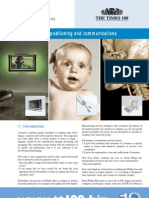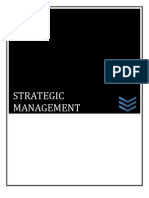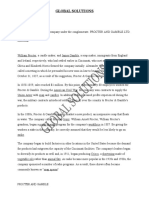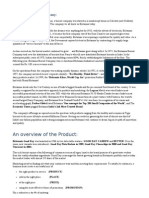Goodnessknows: Healthy Snack Squares That Failed To Establish Their Place in Uk Market
Goodnessknows: Healthy Snack Squares That Failed To Establish Their Place in Uk Market
Uploaded by
SamarthCopyright:
Available Formats
Goodnessknows: Healthy Snack Squares That Failed To Establish Their Place in Uk Market
Goodnessknows: Healthy Snack Squares That Failed To Establish Their Place in Uk Market
Uploaded by
SamarthOriginal Title
Copyright
Available Formats
Share this document
Did you find this document useful?
Is this content inappropriate?
Copyright:
Available Formats
Goodnessknows: Healthy Snack Squares That Failed To Establish Their Place in Uk Market
Goodnessknows: Healthy Snack Squares That Failed To Establish Their Place in Uk Market
Uploaded by
SamarthCopyright:
Available Formats
GoodnessKnows
Healthy snack squares that failed to
establish their place in UK market
MarketLine Case Study
Report Code: ML00030-040
Published: July 2019
GoodnessKnows: Healthy snack squares that failed to establish their place in UK market
Published: July 2019 ML00030-040 Case Studies
1. Overview
1.1. Catalyst
Venturing into the UK healthy food market, Mars believed the transportation of the GoodnessKnows brand from the United
States would prove to be a commercial hit. The company failed in its ambition. Instead of initiating heavy sales the product
largely failed due to poor packaging design, an advertising campaign that failed to create brand awareness, and failing to
connect with a target audience. Over-production ensured the product became an expensive failure for Mars.
1.2. Summary
Mars wanted to bring its North American success of GoodnessKnows, a ‘healthy’ fruit and nut bar, to the UK, in an attempt to
penetrate the healthy snack market independently. It launched the range of products in the UK during July 2017; however
the brand was discontinued as of December 2018. Confectionary company Mars invested £4.6m ($5.9m) on advertising and
sampling the range within the UK. This is the most they have spent on a campaign since the release of their Celebrations
chocolate selection 20 years ago. Due to increasing consumer awareness of ethical issues Mars also pledged to donate 10%
of the profits of this product to charity.
A contributing factor to their failure was their packaging, which was simple and emphasized the use of natural ingredients
and being GMO free. Whereas the branding shows that they are low calorie despite containing chocolate. This is definitely a
missed opportunity as supported by the GlobalData 2018 Q3 UK Consumer Survey results on the right that show 63% of
British consumers enjoy snacking on chocolate the most. The marketing campaign in the UK was not to everyone's taste, as it
shows a character by the name of Mr. Nasty going through the day doing unpleasant things such as popping a couples'
balloon and blowing out the candles of an elderly ladies birthday cake.
© MarketLine 2019. This product is licensed and is not to be photocopied.
1
GoodnessKnows: Healthy snack squares that failed to establish their place in UK market
Published: July 2019 ML00030-040 Case Studies
Table of Contents
1. OVERVIEW 1
1.1. Catalyst 1
1.2. Summary 1
2. POOR MARKETING AND PACKAGE DESIGN BEHIND DEMISE OF GOODNESSKNOWS IN UK 1
2.1. US success suggested GoodnessKnows could crack the UK healthy snack market 1
2.1.1. Underperformance proved terminal for the UK release 2
2.2. 'Goodness Knows' has failed to diversify Mars' portfolio within the UK 2
2.2.1. Wrapper packaging defied the convenience of the squares 2
2.3. GoodnessKnows British advertising material failed to create interest 3
2.4. Over-production of stock, failure to change consumers brand perception and poor marketing
and design contributed to loss 4
2.5. Understanding and addressing the needs/desires of the target audience is key for brands
4
3. APPENDIX 6
3.1. Sources 6
3.2. Further reading 6
4. ASK THE ANALYST 6
5. ABOUT MARKETLINE 6
© MarketLine 2019. This product is licensed and is not to be photocopied.
1
GoodnessKnows: Healthy snack squares that failed to establish their place in UK market
Published: July 2019 ML00030-040 Case Studies
List of Figures
Figure 1: GoodnessKnows 1
Figure 1: GoodnessKnows packaging 2
Figure 1: GoodnessKnows UK advert 3
© MarketLine 2019. This product is licensed and is not to be photocopied.
2
GoodnessKnows: Healthy snack squares that failed to establish their place in UK market
Published: July 2019 ML00030-040 Case Studies
List of Tables
No table of figures entries found.
© MarketLine 2019. This product is licensed and is not to be photocopied.
3
GoodnessKnows: Healthy snack squares that failed to establish their place in UK market
Published: July 2019 ML00030-040 Case Studies
2. Poor marketing and package design behind
demise of GoodnessKnows in UK
GoodnessKnows are small snack squares that come in packs of four and are made of oats, fruits, nuts and spices. The
company has failed to succeed in the UK and was discontinued within a year of going on sale. The product itself met many
requirements for a healthy on the go snack but unfortunately missed many opportunities to be successful. The content was
meant to give the consumer an option to eat it in up to four sittings, but the packaging made this difficult. Worse still, the
packaging was plain and fell into the background on retailer shelves.
2.1. US success suggested GoodnessKnows could crack the UK
healthy snack market
Mars wanted to bring its North American success of GoodnessKnows, a ‘healthy’ fruit and nut bar, to the UK, in an attempt to
penetrate the healthy snack market there independently. It launched the range of products in the UK during July 2017; they
were however they were discontinued by December 2018. GoodnessKnows is an on-the-go low calorie (160kcal) snack with
four individual squares for consumers to snack on. The product's marketing emphasizes having ‘real’ fruit, nuts and dark
chocolate. The squares were made to look as if they had been homemade as they looked rustic and were dipped in
chocolate. This is a trend that larger companies are using more frequently. The concept is called ‘small stealth branding’.
Figure 1: GoodnessKnows
© MarketLine
Source: Facebook
In order to fulfil the requirements of being a ‘healthy’ snack, Mars ensured that GoodnessKnows was natural, high in protein,
low sugar and a low calorie product. This matches consumers’ expectations and desires across the globe when choosing a
‘healthy’ snack, as indicated by the GlobalData Q4 Consumer Survey 2017 results. The squares also boasted not having
artificial colors, flavors, preservatives or high fructose corn syrup. It came in a range of flavors including apple, peach and
blueberry. They were also high in protein due to the high content of nut, as well as their own recipe nut butter which was
used to bind the squares. The product was retailing at £1.50 ($1.90) per pack of four squares.
© MarketLine 2019. This product is licensed and is not to be photocopied.
1
GoodnessKnows: Healthy snack squares that failed to establish their place in UK market
Published: July 2019 ML00030-040 Case Studies
2.1.1. Underperformance proved terminal for the UK release
Mars invested £4.6m ($5.9m) on advertising and sampling the range within the UK. This is the most they have spent on a
campaign since the release of their Celebrations chocolate selection 20 years ago. Due to increasing consumer awareness of
ethical issues Mars also pledged to donate 10% of the profits of this product to charity. The campaign mainly consisted of the
TV advert. Despite their efforts, the range has underperformed in the UK, unlike in the USA. Subsequently, they have decided
to discontinue the range and focus on their minority stake in Kind, a natural snack bar which has been fast growing in the UK.
In an age where consumers are increasingly concerned with choosing healthier lifestyle options this product could have been
huge, especially amongst millennials.
2.2. 'Goodness Knows' has failed to diversify Mars' portfolio within
the UK
The healthy snack bar market in the UK is highly competitive and currently saturated with many well established brands, such
as: Nakd bars, BelVita Biscuits Nutri-grain, Eat Natural, Nature Valley, Bounce Energy Balls and many more. Nakd bars for
instance consist mainly of fruit and nuts (some have cereals) and they come in a variety of flavors, most of which are similar
to what Goodness Knows was offering. They also market their food as raw, whole and healthy and the products are of similar
weight and size to GoodnessKnows and have been established in the UK since 2005. Consumers looking to grab a healthy
snack were more likely to pick up an established brand over one that has been created by Mars. Traditionally, Mars products
are associated with high calorie indulgence products and would not be the default option for a consumer looking to get a
healthy snack. Competition did not feel the need to react to the release of GoodnessKnows. This suggests that the company
was confident enough in the product portfolio to not feel threatened by the new release. In terms of nutritional value,
competitors such as Nakd, Kellogg's, Bounce4 and Nature Valley had less sugar and fat, which are deemed as unhealthy. The
competitors’ products also contained higher amounts of fiber and protein which means these products were of higher
nutritional value and quality.
2.2.1. Wrapper packaging defied the convenience of the squares
Another contributing factor to their failure was packaging, which was simple and emphasized the use of natural ingredients
and being GMO free. Whereas the branding shows that they are low calorie despite containing chocolate. This was definitely
a missed opportunity as supported by the GlobalData 2018 Q3 UK Consumer Survey results on the right that show 63% of
British consumers enjoy snacking on chocolate the most. Other brands highlight these key features or use see-through
packaging to show what the consumer is getting. This would have not stood out next to competing products on retailer
shelves. The retailers were UK supermarkets that would be stocking colorful Nakd and other competitor bars closely.
Figure 2: GoodnessKnows packaging
© MarketLine
Source: Bakery and Snacks
© MarketLine 2019. This product is licensed and is not to be photocopied.
2
GoodnessKnows: Healthy snack squares that failed to establish their place in UK market
Published: July 2019 ML00030-040 Case Studies
These brands highlight their attributes clearly in bright colors or have see-through packaging to show the actual product
which supports their claims of being ‘natural’ or ‘raw’. GoodnessKnows would have been easily overlooked in a supermarket
shelf against its contenders. Emphasizing their high protein content, as 20% of the bar was made from Mars' unique almond
and peanut butter which was the binding agent was the binding agent for the squares would have helped them standout.
GoodnessKnows packaging contradicted its purpose.
Their competitors' goods come in individual portions which are easy to consume and efficient for the on-the-go market.
Whereas these squares could be eaten in four sittings, the packaging was not resealable and consumers were likely to eat all
the squares in one sitting, making the packaging inefficient for multiple portions. 'GoodnessKnows' may have budgeted on
their packaging, keeping it plain and inefficient for the purpose of the product. This means that if consumers were willing to
give it a go, they were unlikely to buy them again.
2.3. GoodnessKnows British advertising material failed to create
interest
The marketing campaign in the UK was not to everyone's taste, as it shows a character by the name of Mr Nasty going
through the day doing unpleasant things such as popping a couples' balloon and blowing out the candles of an elderly ladies
birthday cake. He then eats the snack at the end of the advert which is meant to depict that he has done a good deed which
should justifies all his other unpleasant behavior within the day. Many people don't want to be associated with these
character traits and find it difficult to relate.
Figure 3: GoodnessKnows UK advert
© MarketLine
Source: Convenience Store
Whereas in the US advertising showed GoodnessKnows consumers getting an opportunity to act, which is something they
had always wanted to do, this portrays the brand image in a positive and warm light. It captured moments of people making
funny blunders and came across as warm and sincere, making it more endearing and attractive amongst a larger audience. In
the British advert Mr. Nasty is also an older gentleman, whereas the ideal target demographic for GoodnessKnows should
have been millennials.
© MarketLine 2019. This product is licensed and is not to be photocopied.
3
GoodnessKnows: Healthy snack squares that failed to establish their place in UK market
Published: July 2019 ML00030-040 Case Studies
This is because millennials are the largest age group in Britain to consume chocolate products as a snack, as per the
GlobalData Q3 2018 Consumer Survey findings. Therefore the campaign should have featured a relatable character for them;
instead it showed them also as another target of Mr. Nasty.
2.4. Over-production of stock, failure to change consumers brand
perception and poor marketing and design contributed to loss
They have inflated their own loss as they were producing 80,000 units per hour for their first year in the UK, meaning that
there was more supply than demand for the product. The squares also include an abundance of expensive ingredients such
as nuts, which would have contributed to low margins and high overheads. Another hindrance to the success of Mars was
that the brand has a strong association with indulgence in the UK. This is due to their popularity within the confectionary
industry with brands such as: Celebrations, Mars bars, Snickers bars and so on. This means that consumers associate the
Mars brand to unhealthy, high fat and sugar filled snacks. Mars products would not be the default option for a healthy snack
for most consumers. The GlobalData 2017 Q4 Consumer Surveys findings show that consumers associate ‘natural’, ‘low in
sugar’ and ‘low in fat’ to healthy snacks, whereas Mars' British product portfolio consists of conventionally unhealthy foods
and beverages.
In the US they have a strong social media presence including a hashtag (#tryalittlegoodness) and have sponsored social
media celebrities to endorse them. This shows the product being eaten in many way including smoothie bowls and other
inspiring recommendations. The same strategy could have been used within the UK and the product could have become
successful. Overall, GoodnessKnows did not have anything special to offer consumers to buy the product over other brands.
The attempt to create a healthy stealth small brand has not got off on the right foot within the UK due to their poor
marketing strategy and packaging, as well the association of Mars to unhealthy snacks. However, this is likely to change in
future due to its shares in Kind health bars. Having a stake in an established ‘healthy’ snack brand provides benefits such as a
route to the market with less risk association. Kind bars are also familiar to consumers.
2.5. Understanding and addressing the needs/desires of the target
audience is key for brands
Packaging and marketing should be fit to meet the products purpose. In this case the packaging was not resalable and
functional enough to eat the squares in separate sittings. The packaging was also too bland in comparison to competitor
products and brands. It is important for companies to research competitors in order to have consumer appeal, and ultimately
demand. Without product differentiation a company risks having its goods fall into the background. Highlighting claims that
engage consumers is very important. GlobalData research shows what traits consumers perceive to be healthy; these should
be made obvious to the consumers via packaging or marketing strategies. These trends have been growing since that data
was published, with the likes of Huel and other high protein on the go products entering the market. Millennials and many
other consumers have become conscious of a low carb, sugar and fat diet in order to help reduce fat and maintain weight
levels. Content design should be convenient and effective. In this case the squares were not a suitable option for an on the
go product. A product should aim to fulfil the criteria it claims.
The advertisement for a product should appeal to a particular demographic rather than mass market. The main character or
concept should also reflect the brands image and the targeted demographic in order to ensure consumers are attracted or
can relate to the product. The marketing and advertising methods should also expand out to social media campaigns to
engage consumer interests and to also create a relationship with the brand; this could be done with the use of hashtags,
online polls and online promotional offers. This is especially true if targeting a younger demographic. Companies should
know clearly who they are targeting and then they can market and advertise the brand or product accordingly and engage
better with potential consumers.
© MarketLine 2019. This product is licensed and is not to be photocopied.
4
GoodnessKnows: Healthy snack squares that failed to establish their place in UK market
Published: July 2019 ML00030-040 Case Studies
Supply should also match demand, over production of a product in a new market comes with high levels of risk, as without
adequate supply the goods will not be profitable. Strong market research must also be used to negate such risk – this is
especially true for new releases
© MarketLine 2019. This product is licensed and is not to be photocopied.
5
GoodnessKnows: Healthy snack squares that failed to establish their place in UK market
Published: July 2019 ML00030-040 Case Studies
3. Appendix
3.1. Sources
Bakery and Snacks
https://www.bakeryandsnacks.com/Article/2015/05/29/Mars-appeals-to-health-conscious-consumer-with-goodnessknows-
launch
Convenience Store
https://www.conveniencestore.co.uk/products/mars-creates-first-goodness-knows-tv-advert/559714.article
Facebook
https://www.facebook.com/goodnessKNOWS/
3.2. Further reading
United Kingdom – Foodservice – Industry Profiles published by MarketLine
United Kingdom – Food & Grocery retail – Industry Profiles published by MarketLine
4. Ask the analyst
We hope that the data and analysis in this case study will help you make informed and imaginative business decisions. If you
have any questions or further requirements, MarketLine's research team may be able to help you. The MarketLine Research
team can be contacted at ReachUs@MarketLine.com.
5. About MarketLine
At MarketLine, we deliver accurate, up-to-date insights on over 100,000 companies, 3,500 industries, 215 countries, and
3,000 cities as well as the latest news and financial deal information from within your market and across the globe.
Established in 1997 when the Internet was in its infancy, we recognized the need for a convenient and reliable data service to
help our clients understand local and global markets and the companies operating within them.
In today’s information-rich world, sifting fact from fiction to pick out what’s relevant and what’s up to date has become the
new ‘holy grail’ in business information provision.
Hundreds of dedicated research professionals aggregate, analyze, and cross-check facts in line with our strict research
methodology, ensuring a constant stream of new and accurate information is added to MarketLine every day.
© MarketLine 2019. This product is licensed and is not to be photocopied.
6
GoodnessKnows: Healthy snack squares that failed to establish their place in UK market
Published: July 2019 ML00030-040 Case Studies
© MarketLine 2019. This product is licensed and is not to be photocopied.
7
You might also like
- EY Parthenon Premium Skincare MarketDocument20 pagesEY Parthenon Premium Skincare MarketSamarthNo ratings yet
- Integrated Marketing Communication of DominosDocument23 pagesIntegrated Marketing Communication of DominosSrishti MangalNo ratings yet
- Marketing NestoDocument9 pagesMarketing NestoMyassignmentPro VideoNo ratings yet
- 2023 First Team Assignment M1Document3 pages2023 First Team Assignment M1Wanjiru R0% (1)
- Case Study IIDocument18 pagesCase Study IIHf CreationNo ratings yet
- The Complete Guide to Hedge Funds and Hedge Fund StrategiesFrom EverandThe Complete Guide to Hedge Funds and Hedge Fund StrategiesRating: 3 out of 5 stars3/5 (1)
- Strategic Management Main Project On BritanniaDocument61 pagesStrategic Management Main Project On Britanniadevashree76% (21)
- Global Brand Power: Leveraging Branding for Long-Term GrowthFrom EverandGlobal Brand Power: Leveraging Branding for Long-Term GrowthRating: 5 out of 5 stars5/5 (1)
- MKT 621 Quiz Four FilesDocument4 pagesMKT 621 Quiz Four FilesImran RazaNo ratings yet
- Re Positioning PhilipsDocument4 pagesRe Positioning Philipsapi-3730856100% (1)
- Back, Complaint, Exchange, Manager, Receipt, Refunds, ReturnDocument5 pagesBack, Complaint, Exchange, Manager, Receipt, Refunds, ReturnЮля КозарNo ratings yet
- Kilgo's 2nd Grade Question StemsDocument3 pagesKilgo's 2nd Grade Question StemsEsmeralda CartagenaNo ratings yet
- Research MethodologyDocument26 pagesResearch MethodologyHimanshiShah100% (1)
- BritanniaDocument31 pagesBritanniaShikha KushwahaNo ratings yet
- Oatly Case StudyDocument11 pagesOatly Case StudyIl MulinaioNo ratings yet
- Strategic Management Main Project On BritanniaDocument60 pagesStrategic Management Main Project On BritanniacharuNo ratings yet
- Britannia ReportDocument33 pagesBritannia Reportxyz1No ratings yet
- Reach & CoverageDocument5 pagesReach & Coverageshambhu14372No ratings yet
- Birds Eye and The UK Frozen FoodDocument4 pagesBirds Eye and The UK Frozen FoodMirza JunaidNo ratings yet
- Pickled Market Research Report - Catherine Ouellet-CompressedDocument37 pagesPickled Market Research Report - Catherine Ouellet-Compressedapi-671915564No ratings yet
- IIMS Journal Vol 3 Issue 1 Jan 2024Document6 pagesIIMS Journal Vol 3 Issue 1 Jan 2024vedantpatnaik.privNo ratings yet
- Britannia ReportDocument33 pagesBritannia ReportSrikanth Tyada0% (1)
- Marketing Communications PlanDocument21 pagesMarketing Communications PlankhandywilsonNo ratings yet
- Assignment On: Fundamentals of MarketingDocument20 pagesAssignment On: Fundamentals of MarketingArnab DharNo ratings yet
- Cost AccoutingDocument37 pagesCost AccoutingDonaRubichenNo ratings yet
- Extending The Product Life Cycle Through Re-Positioning With Reference To Cadbury SnackDocument17 pagesExtending The Product Life Cycle Through Re-Positioning With Reference To Cadbury SnackYogesh KendeNo ratings yet
- SUNFEASTDocument5 pagesSUNFEASTSuriyaNo ratings yet
- 38 - Mayank - Part 1Document15 pages38 - Mayank - Part 1Mayank SinghalNo ratings yet
- Britannia ProjectDocument8 pagesBritannia ProjectShivendra AwasthiNo ratings yet
- Case Study Final 1Document33 pagesCase Study Final 1adityarajrauth583No ratings yet
- SWOT Analysis of CadburyDocument6 pagesSWOT Analysis of CadburyUtami Manggi Asih Anggar WulanNo ratings yet
- Me Project ReportDocument16 pagesMe Project Reportjoshipragati123No ratings yet
- Executive SummaryDocument6 pagesExecutive SummaryArnavNo ratings yet
- Marketing Analysis: BritanniaDocument22 pagesMarketing Analysis: Britanniaabhijitsamanta191% (23)
- Britannia Cream BuiscuitsDocument24 pagesBritannia Cream BuiscuitsLokesh KumarNo ratings yet
- Marketing Plan Sample - 2Document18 pagesMarketing Plan Sample - 2JIAWEN YUNo ratings yet
- Britannia Case StudyDocument14 pagesBritannia Case StudyChhotuNo ratings yet
- Britannia BiscuitsDocument27 pagesBritannia BiscuitsJanardhanamurthy JanardhanNo ratings yet
- Britannia FinalDocument38 pagesBritannia Finalbhagvat solanke100% (1)
- Britannia 8 PDF FreeDocument35 pagesBritannia 8 PDF FreeAnsh PandeyNo ratings yet
- Britannia Biscuits: Introduction of Britannia IndustriesDocument4 pagesBritannia Biscuits: Introduction of Britannia Industriesganguli_tanmoyNo ratings yet
- Project Report On BritanniaDocument30 pagesProject Report On BritanniaMubashshir Raza100% (3)
- Study of Product Promotion & Marketing Strategies of United BiscuitsDocument47 pagesStudy of Product Promotion & Marketing Strategies of United BiscuitsWaseem Asghar50% (2)
- Vegan Burger: Iceland'S No Bull Burger Becomes Top Seller: Marketline Case StudyDocument10 pagesVegan Burger: Iceland'S No Bull Burger Becomes Top Seller: Marketline Case StudyAbhishek SharmaNo ratings yet
- My Company Is Subsidiary Company Under The ConglomerateDocument15 pagesMy Company Is Subsidiary Company Under The Conglomerateashley0902No ratings yet
- Walkers FinalDocument25 pagesWalkers FinalSufy SaabNo ratings yet
- London School of Commerce: Masters in Business AdministrationDocument20 pagesLondon School of Commerce: Masters in Business AdministrationSaki Mohammad100% (1)
- London Crisp Co.'s Export Plan To ItalyDocument23 pagesLondon Crisp Co.'s Export Plan To ItalySumant KhetanNo ratings yet
- Parle G Presentation (Autosaved)Document13 pagesParle G Presentation (Autosaved)Priya JoshiNo ratings yet
- Project in Production Process of Biscuits (Britannia)Document26 pagesProject in Production Process of Biscuits (Britannia)Garima JoshiNo ratings yet
- BritanniaDocument35 pagesBritanniaNitinAgnihotriNo ratings yet
- Britannia FinalDocument39 pagesBritannia FinalNitinAgnihotri100% (1)
- Final Project Seemtter 2Document108 pagesFinal Project Seemtter 2Aanya SinghNo ratings yet
- Britannia ProjectDocument7 pagesBritannia Projectmajor_saini06No ratings yet
- Cadbury Dairy MilkDocument7 pagesCadbury Dairy Milkrolando mabaquiaoNo ratings yet
- Nestle Marketing Strategy 1Document17 pagesNestle Marketing Strategy 1RUPESHmechcitNo ratings yet
- Britannia Project ReportDocument31 pagesBritannia Project ReportNikky NamdeoNo ratings yet
- Marketing Management & Strategy Group Assignment ReportDocument0 pagesMarketing Management & Strategy Group Assignment Report000eleni000No ratings yet
- Marketing PocketbookDocument9 pagesMarketing PocketbookSophanut Arrapornnopparat100% (1)
- Britannia Direct Dil SeDocument28 pagesBritannia Direct Dil SeModak Priy SinghNo ratings yet
- An Overview of The CompanyDocument7 pagesAn Overview of The CompanyBhargav PatelNo ratings yet
- Market Cosmetic in UKDocument4 pagesMarket Cosmetic in UKPoupeau AnthonyNo ratings yet
- Nithish ProjectDocument10 pagesNithish Projectgeniusgamer1600No ratings yet
- Cadbury's Purple Reign: The Story Behind Chocolate's Best-Loved BrandFrom EverandCadbury's Purple Reign: The Story Behind Chocolate's Best-Loved BrandRating: 5 out of 5 stars5/5 (1)
- How To Make A Million Dollars With Crickets: The Ultimate Guide To Profitable Cricket FarmingFrom EverandHow To Make A Million Dollars With Crickets: The Ultimate Guide To Profitable Cricket FarmingNo ratings yet
- Admissions Feedback Analysis: A Corporate Communications Committee InitiativeDocument10 pagesAdmissions Feedback Analysis: A Corporate Communications Committee InitiativeSamarthNo ratings yet
- Nov - Design Vertical ReportDocument3 pagesNov - Design Vertical ReportSamarthNo ratings yet
- JCC Admissions TasksDocument3 pagesJCC Admissions TasksSamarthNo ratings yet
- Permission LetterDocument1 pagePermission LetterSamarthNo ratings yet
- Beyond This Challenge: What The Coronavirus Response TeachesDocument2 pagesBeyond This Challenge: What The Coronavirus Response TeachesSamarthNo ratings yet
- Admission Committee Task Senior TeamDocument1 pageAdmission Committee Task Senior TeamSamarthNo ratings yet
- Phase: College Admission Forms - CAT 2020Document4 pagesPhase: College Admission Forms - CAT 2020SamarthNo ratings yet
- OPJEMS 2020 BrochureDocument2 pagesOPJEMS 2020 BrochureSamarthNo ratings yet
- OPJEMS Process PDFDocument9 pagesOPJEMS Process PDFSamarthNo ratings yet
- OPJEMS 2020 PostureDocument1 pageOPJEMS 2020 PostureSamarthNo ratings yet
- Digital Transformation: Presented by You ExecDocument12 pagesDigital Transformation: Presented by You ExecSamarthNo ratings yet
- 2 Kaamchor: Samartha Agrawal - Chetan SodhiDocument7 pages2 Kaamchor: Samartha Agrawal - Chetan SodhiSamarthNo ratings yet
- Frequently Asked Questions: 1. ApplicationDocument5 pagesFrequently Asked Questions: 1. ApplicationSamarthNo ratings yet
- 2 Kaamchor: Samartha Agrawal - Chetan SodhiDocument7 pages2 Kaamchor: Samartha Agrawal - Chetan SodhiSamarthNo ratings yet
- Frequently Asked Questions: Indian Railways Passenger Enquiry Air India Indian Yellow PagesDocument3 pagesFrequently Asked Questions: Indian Railways Passenger Enquiry Air India Indian Yellow PagesSamarthNo ratings yet
- CGPI To PercentageDocument1 pageCGPI To PercentageSamarthNo ratings yet
- Welcome To Google Analytics For BeginnersDocument11 pagesWelcome To Google Analytics For BeginnersSamarthNo ratings yet
- The Star News December 11 2014Document40 pagesThe Star News December 11 2014The Star NewsNo ratings yet
- Procter and Gamble - MarketingDocument10 pagesProcter and Gamble - MarketingIvana Panovska100% (5)
- Economics and Computation 1Document15 pagesEconomics and Computation 1Zachry WangNo ratings yet
- Faya II Ilyes RalucaDocument10 pagesFaya II Ilyes RalucaIlyes Raluca-AndreeaNo ratings yet
- Rhetorical AnalysisDocument5 pagesRhetorical AnalysisMatthew EilbacherNo ratings yet
- Cambridge IGCSE™: Travel & Tourism 0471/21Document13 pagesCambridge IGCSE™: Travel & Tourism 0471/21minalsehrNo ratings yet
- Sylvia - Impact of Digital Marketing On Sales Growth of Small and Medium Enterprises in Nairobi, KenyaDocument58 pagesSylvia - Impact of Digital Marketing On Sales Growth of Small and Medium Enterprises in Nairobi, Kenyaleone shikuku100% (1)
- You TubeDocument42 pagesYou Tubessmith21385No ratings yet
- AP American Government: Chapter Ten: The MediaDocument6 pagesAP American Government: Chapter Ten: The MediairregularflowersNo ratings yet
- Guide To CopywritingDocument9 pagesGuide To Copywritingin678No ratings yet
- MKPLANDocument66 pagesMKPLANellamvillanueva1No ratings yet
- MKT 4229: Consumer Behaviour Coursework Instruction JANUARY 2021Document5 pagesMKT 4229: Consumer Behaviour Coursework Instruction JANUARY 2021Darren Tan Chee ZheNo ratings yet
- Reading 162-169Document8 pagesReading 162-169Phương DiiNo ratings yet
- Consumer Behaviour Towards Social MediaDocument58 pagesConsumer Behaviour Towards Social MediaLashPrabhaSekarNo ratings yet
- The Role of Storytelling in AdvertisingDocument11 pagesThe Role of Storytelling in AdvertisingmaNo ratings yet
- Sinaunang TaoDocument14 pagesSinaunang TaorhaicamorenoNo ratings yet
- Ethics in Marketing and Advertising Distribution ManagementDocument38 pagesEthics in Marketing and Advertising Distribution ManagementJohanna TesadoNo ratings yet
- The Effects of Subliminal Messages On Human Attitude Change and Effective AdvertisingDocument15 pagesThe Effects of Subliminal Messages On Human Attitude Change and Effective AdvertisingIJAR JOURNALNo ratings yet
- Marketing Strategy of Big Bazaar IndiaDocument14 pagesMarketing Strategy of Big Bazaar Indiashailendra0% (1)
- TCM 131 FinalDocument5 pagesTCM 131 Finalbob robNo ratings yet
- WIA1001-Final U2005405Document1 pageWIA1001-Final U2005405XY LNo ratings yet
- A Study On Consumer Attitude Towards John Deere Tractor: A Case Study of BALAJI TRACTORS HAVERIDocument61 pagesA Study On Consumer Attitude Towards John Deere Tractor: A Case Study of BALAJI TRACTORS HAVERISarva ShivaNo ratings yet
- Southwestern Ohio Steel Company LPDocument5 pagesSouthwestern Ohio Steel Company LPAbhimanyu DevNo ratings yet
- Ashlyn Pankow Final PaperDocument23 pagesAshlyn Pankow Final Paperapi-754066419No ratings yet











































































































